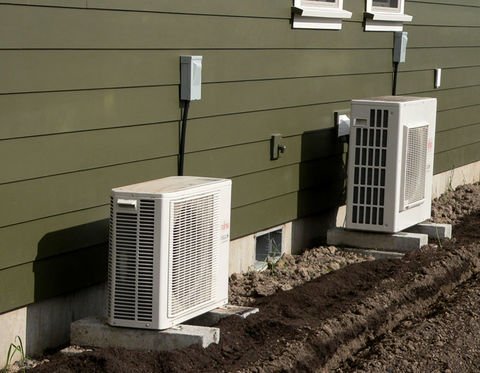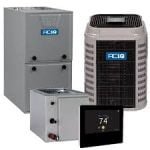Oil Furnace vs Mini Split: Choosing between an oil furnace and a mini-split to heat your home can be difficult if you want to upgrade your heating system. Both systems have advantages and disadvantages, and the best choice depends on your needs, preferences, and budget.
In this blog post, we will compare oil furnace vs mini split in terms of performance, efficiency, cost, and environmental impact. We will also provide tips on choosing the best heating system for your home.
What is an Oil Furnace?
An oil furnace is a heating system that utilizes heating oil as a fuel source to heat your home efficiently. Heating oil is a liquid fueling product given to your home through a truck. An oil furnace creates heat due to the process of combustion(the process of heat creation by the burning of fuel). Then, the heat is distributed to your home via a network of vents and ducts. It can also provide hot water for your home.
What is a Mini Split?
A mini-split is also known as a ductless heating system. The heating mechanism of mini splits works without the network of ducts to distribute heat to your home. However, a mini-split consists of two major components: an outdoor unit and an indoor unit.
The outdoor unit of the mini-split contains a condenser and a compressor, which help transfer heat from one spot to another. The indoor unit includes an evaporator and a fan, responsible for assigning heat to the rooms. It can also cool your rooms by reversing the heating mechanism.

Understanding Oil Furnace vs Mini Split: Factors To Distinguish Them
Here are some essential factors to consider when comparing oil furnace vs mini split heating systems and choosing the best one for your home.
| Aspect | Oil Furnace | Mini Split |
| Heating Method | Burns oil for heating, relying on a fuel source. | Utilizes electricity for both heating and cooling, offering versatility. |
| Energy Efficiency | Typically has moderate to high efficiency, especially in newer models. | Known for excellent energy efficiency due to the absence of fuel combustion. |
| Installation | Requires a ductwork system for heat distribution, which can be costly and time-consuming. | Ductless, making installation quicker and more cost-effective. |
| Zoning and Control | Limited zoning and control options often heat the entire house simultaneously. | Provides precise zoning and control with separate indoor units for different areas. |
| Initial Cost | Generally, it is more affordable upfront but may require ductwork installation costs. | It may have a higher initial cost but offers energy savings and reduced installation expenses. |
| Operating Cost | Operating costs can be higher due to oil prices and potential inefficiencies. | Driving costs are typically lower thanks to energy-efficient operation. |
| Environmental Impact | Burning oil contributes to air pollution and carbon emissions. | Environmentally friendly with no combustion, reducing carbon footprint. |
| Maintenance and Lifespan | Requires regular maintenance and lasts 15-30 years. | Requires minimal maintenance and has a lifespan of 20-30 years. |
| Climate Suitability | Suitable for cold climates with access to affordable oil. | It is ideal for various climates, offering both heating and cooling capabilities. |
| Versatility | is primarily for heating, cooling requires a separate system. | It provides both heating and cooling in one system, increasing versatility. |
| Noise Levels | Oil furnaces tend to be noisier during operation. | Mini Splits are quieter, providing a more peaceful indoor environment. |
Are Mini Splits More Efficient Than Oil Heat?
Mini-splits are more efficient than oil heat in most situations, especially when the outside temperature is above freezing. Heat pump technology is used in mini splits to move heat from the outside to the inside, whereas oil heaters use fuel to generate heat. Mini-splits emit fewer greenhouse gases and can provide tailored heating for different areas of the home. One of the factors that affect the efficiency of mini splits is subcooling and its role in the refrigeration cycle.
Why Is a Heat Pump Better Than An Oil Furnace?
A heat pump is better than an oil furnace for several reasons:
An Oil Furnace vs Mini Split Cost
The cost of an oil furnace vs mini split depends on several factors, such as
- The size and capacity of the unit
- The type and quality of the unit
- The availability and price of the fuel or power source
- The installation and labor fees
- The maintenance and repair fees
- The energy consumption and efficiency of the unit
- The lifespan and warranty of the unit
An oil furnace’s higher operating costs stem from greater energy use and maintenance needs. Annual oil consumption varies (500-1,500 gallons) based on unit size, efficiency, climate, and usage. Oil prices, generally above electricity prices, fluctuate. Maintenance entails oil filters, nozzles, electrode replacements, and chamber and flue cleaning, costing $100-$500 per year, depending on unit condition and age.
In contrast, mini-splits offer lower operating costs due to reduced energy consumption and maintenance. Annual electricity consumption ranges from 545 to 1,000 watts for cooling and 1,000 to 7,500 watts for heating.
Electricity prices are typically lower than heating oil prices. Minimal maintenance involves air filter replacement, indoor and outdoor unit cleaning, and refrigerant level/pressure checks, with costs ranging from $50 to $300 annually, dependent on unit condition and age.
The Benefits of Using an Oil Furnace
An oil furnace is not without its benefits, such as:
- An oil furnace has a higher heating capacity than a mini split, which means it can produce more heat in a shorter period of time, which is helpful in cooling areas or when you require a sudden boost of heat. However, a mini-split may have a smaller heating capacity than an oil furnace.
- An oil furnace is self-sufficient, running independently of the power grid or weather conditions and relying on the heating oil in your tank. On the other hand, a mini-split is dependent on power and heat quality, which can be influenced by surroundings such as temperature, humidity, and wind.
- Oil furnaces are more adaptable since they can operate with your existing ductwork, vents, and hot water tank. Alternatively, mini-splits require a separate, possibly tricky installation and a separate hot water system, which can be more expensive and inefficient.
Summary
In conclusion, comparing oil furnace vs mini split involves performance, efficiency, cost, and environmental impact. The choice depends on your specific needs, preferences, and budget. Here are guidelines to assist you:
- In icy climates with temperatures below 0°F, opt for an oil furnace due to its superior heating capacity and weather independence.
- For milder climates above 0°F, consider a mini-split for its higher efficiency and reduced environmental impact.
- In mixed climates with varying temperatures, use a hybrid system, primarily relying on a mini-split, with an oil furnace for backup or supplementary heating when necessary.





